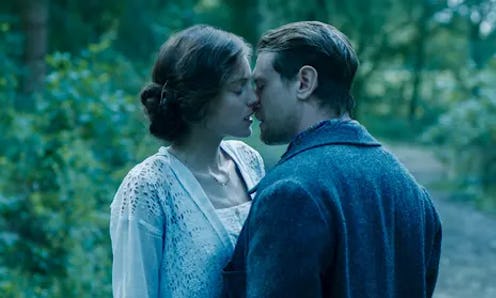Books
The Lady Chatterley’s Lover Book Leaves Us With A Troubling Question
D. H. Lawrence’s novel broke major ground, but its ending may not match your expectations.

D.H. Lawrence’s respected 1928 novel Lady Chatterley’s Lover has seen its fair share of on-screen adaptations. The latest, a Netflix offering, sees Emma Corrin, of The Crown fame, star as Lady Constance Chatterley, opposite SAS Rogue Heroes actor Jack O’Connell, who portrays Chatterley’s lover Oliver Mellors. The book itself, first published privately, but not available in its uncensored version until 1959, was notorious for overcoming class boundaries and its explicit descriptions of sex. This led to it being censored and banned in several places.
Aside from being the subject of a landmark obscenity trial involving Penguin Books, Lady Chatterley’s Lover is also notable for being one of the few novels in English literature that frankly addresses female sexual desire. With Netflix’s adaption of the story causing fresh discussions, the book is a hot topic once more. For those of you who haven’t yet enjoyed the novel, read on to find out how it ends.
Upper-middle class Constance Reid, better known as Connie, marries Sir Clifford Chatterley, a handsome aristocrat. Unfortunately, he gets sent to war and returns paralysed from the waist down, an impotent husband. Chatterley becomes a writer and associates with the intellectual and literary circles, who all seem empty and pretentious to Connie. The distance between the couple grows, and Connie has a brief and unsatisfying affair with a visiting playwright, which further reinforces her disappointment in men.
She eventually turns to the Wragby estate’s gamekeeper, Oliver Mellors, who has just returned from a stint in the army. He is aloof and purposefully isolates himself, but carries an innate sensuality that attracts Connie. In an enemies-to-lovers turn of events, they start an affair with each other, but it is only after a tryst in the woods where they experience simultaneous orgasms that Connie feels a deeper connection with Mellors and starts to fall in love with him.
Aside from class divides, a major motif in the novel is the idea that one cannot live by only nourishing the mind; the physical body also needs to be in balance. Connie ends up pregnant by Mellors but, while she is on holiday, his wife Bertha returns. Mellors begins the process of divorcing her, and a vengeful Bertha spreads scandals about him, so by the time Connie returns, Mellors has already been fired from Wragby.
Connie confesses her affair and pregnancy to Lady Chatterley, but her husband refuses to divorce her. The novel ends on a cliffhanger, with Mellors working on a farm, waiting for his divorce to be finalised, and Connie living with her sister — both in limbo, clinging onto the hope that they will one day end up together. The readers are left in limbo, too, having to deal with the troubling question of just what happened to Lady Chatterley and Mellors, and their relationship.